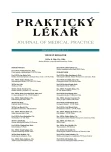Primary prevention of cancer
Authors:
P. Klener
Authors‘ workplace:
Přednosta: prof. MUDr. Marek Trněný, CSc.
; 1. interní klinika 1. LF, VFN a ÚHKT, Praha
Published in:
Prakt. Lék. 2011; 91(9): 512-516
Category:
Reviews
Overview
Stadily worldwide increasing incidence of cancer should be a stimuli to preventive measures, which could significantly reduce cancer rates. Primary prevention of cancer involves firstly identifying factors associated with the development of the disease. Those risk factors are shortly reviewed. Primary prevention could be oriented to environmental and occupational factors, or to implementation of protective measures into practice. Among self-inflicted measures belongs
- cessation of smoking,
- reduced alcohol consumption,
- stop overnutrition, or
- stop unhealthy dietary habits.
Certain role play the protective substances from the food. Diet rich in fruits and vegetable protects against cancer thanks to different mechnisms, mainly through antioxidative potency of natural compounds such as
- luteolin,
- resveratrol,
- lycopene and others.
Chemopreventive effect has been confirmed also from another substances, such as
- retinoids,
- non-steroid antirevmatics,
- antihormons,
- deltanoids, and
- inhibitors of alfa reductase.
All these are described in detail.
Key words:
cancer, primary prevention, risk factors, protective factors, chemoprevention.
Sources
1. Dušek, L., Mužík, J., Gelnarová, E. et al. Cancer incidence and mortality in the Czech Republic. Klin. Onkol. 2010, 23, p. 311-324.
2. Klener, P. Kancerogenní faktory. In: Klener P: Klinická onkologie. Praha: Galén, 2002, s. 40-46.
3. Donaldson, M.S. Nutrition and cancer: A review of the evidence for anti-cancer diet. Nutr. J. 2004, 3, p. 1186-1201.
4. Alexander, D., Weed, D., Cushing, C. et al. Meta-analysis of prospective study of red meat consumption and colorectal cancer. Eur. J. Cancer. Prev. 2011, 20, p. 293-307.
5. Boccardo, E., Villa, L.L. Viral origin of human cancer. Curr. Med. Chem. 2007, 14, p. 2526-2739.
6. Calle, E.E., Rodriguez, C., Walker-Thurmond, K. et al. Overweight, obesity and mortality from cancer in a prospectively studied cohort of US adults. N. Engl. J. Med 2003, 348, p. 1625-1638.
7. Huang, X., Zhu, H.L. Resveratrol and its analogues: promising antitumor agents. Anticancer Agents Med. Chem. 2011, 11, p. ,479-490.
8. Basu, A., Imrhan, V. Tomatoes versus lycopene in oxidative stress and carcinogenesis: Conclusion from clinical trials. Eur. J. Clin. Nutr. 2007, 61, p. 295-303.
9. López-Lázaro, M. Distribution and biological activities of the flavonoid luteolin. Mini Rev. Med. Chem. 2009, 9, p. 31-59.
10. Potter, J.D., Steinmetz, K. Vegetables, fruit and phytoestrogens as preventive agents. IARC Sci. Publ. 1996, 139, p. 61-90.
11. Borechers, A.T., Stem, J.S., Hackman, R.M. et al. Mushrooms, tumors, and immunity. Proc. Soc. Exp. Biol. Med. 1999, 221, p. 281-293
12. Andersen, M.H., Sørensen, R.B., Schrama, D. Cancer treatment:the combination of vaccination with other therapies. Cancer Immunol. Immunother. 2008, 57, p. 1735-1743.
13. Sláma, J. Očkování proti HPV. Klin. Farmakol. Farm. 2008, 22, s. 153-155.
14. Kellof, G.I., Boone, C.W., Crwell, J.A. et al. New agents for cancer chemoprevention. J. Cell. Biochem. 1996, 26, p. 28-36.
15. Rahul Amin, A.R.M., Kucuk, O., Khuri, F.R. et al. Perspectives for cancer prevention with natural compounds. J. Clin. Oncol. 2009, 22, p. 2712-2725.
16. Amin, A.R., Kucuk, O., Khuri, F.R. et al. Perspectives for cancer prevention with natural compounds. J. Clin. Oncol. 2009, 27, p. 2712-2725.
17. Gerattini, E., Gianni, M., Terao, M. Retinoids as differentiating agents in oncology: a network of interactions with intracellular pathways as the basis for rational therapeutic combinations. Curr. Pharm. Des. 2007, 13, p. 1375-1400.
18. Nowak, D., Stewart, D., Koeffler, H.P. Differentiation therapy of leukemia: 3 decades of development. Blood 2009, 113, p. 3655-3665.
19. Fujimura, T., Ohta, T., Oyama, K. et al. Cyclooxygenase-2 (COX-2) in carcinogenesis and selective COX-2 inhibitors for chemoprevention in gastrointestinal cancers. J. Gastrointest. Cancer. 2007, 38, p. 78-82.
20. Rao, C.V., Reddy, B.S. NSAIDs and chemoprevention. Curr. Cancer. Drug. Targets. 2004, 4, p. 29-42.
21. Rizzo, M.T. Cyclooxygenase-2 in oncogenesis. Clin. Chim. Acta 2011, 11, p. 671-687.
22. Lanas, A., Ferrandez, A. NSAIDs and the colon. Curr. Opin. Gastroenterol. 2009, 25, p. 44-49.
23. Bauman, C.K., Castiglione-Gertsch, M. Clinical use of selective estrogen receptor modulators and down regulators with main focus on breast cancer. Minerva Gynecol. 2009, 61, p. 517-539.
24. Sarvis, J.A., Thomson, T.M. Prostate cancer chemoprevention: update of the prostate cancer prevention trial findings and implication for clinical practice. Curr. Oncol. Rep. 2008, 10, p. 529-532.
25. Nickel, J.C., Gilling, P., Tammela, T.L. et al. Comparison of dutasteride and finasteride for treating benign prostatic hyperplasia: The enlarged prostate international comparator study (EPICS). BJU Int. 2011, 108, p. 388-394.
26. Goodwin, P.J., Ennis, M., Pritchard, K.I. et al. Prognostic effects of 25-hydroxyvitamin D levels in early breast cancer. J. Clin. Oncol. 2009, 27, p. 3757-3763.
27. Agoston, E.S., Hatcher, M.A., Kensler, T.W. et al. Vitamin D as anti-cancer agents. Anticancer Agents Med. Chem. 2006, 6, p. 53-71.
28. Spina, C.S., Tangpricha, V., Uskokovic, M. et al. Vitamin D and cancer. Anticancer Res. 2006, 26, p. 2515-2524.
29. Brozmanová, J. Selén a rakovina. Od prevencie k liečbe. Klin. Onkol. 2011, 24, s. 171-179.
Labels
General practitioner for children and adolescents General practitioner for adultsArticle was published in
General Practitioner

2011 Issue 9
Most read in this issue
- Orthostatic hypotension
- Glomus tumour of a finger
- Demodicidosis
- Interaction of alcohol and other drugs: a serious problem
